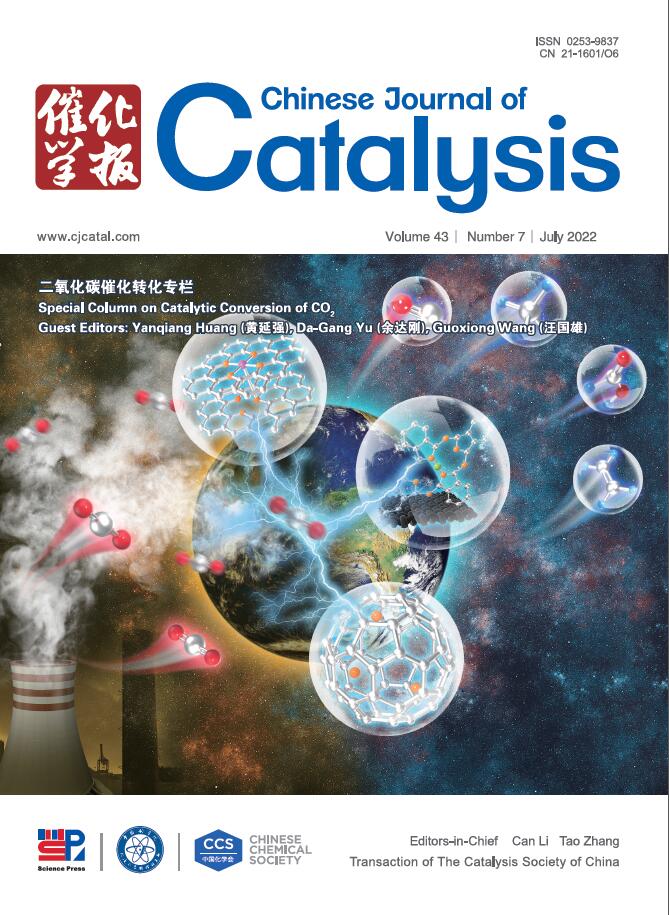在配体覆盖的定义良好的镍纳米团簇上,甘油高效电催化氧化成甲酸
IF 17.7
1区 化学
Q1 CHEMISTRY, APPLIED
引用次数: 0
摘要
甘油电催化氧化制甲酸是甘油转化利用最有前途的途径之一。本文制备了一系列定义明确的Nin(SR)2n纳米团簇(n = 4,5,6,用Ni nc表示),用于电催化甘油氧化生成甲酸,其中Ni6-PET-50CV电催化性能最优,甲酸选择性高达93%,甘油转化率高达86%。这是由于最低的电荷转移阻抗和最快的反应动力学。电化学测量和x射线吸收精细结构测量相结合表明,经过CV扫描预处理和电催化形成Ni - o键后,Ni NCs的结构保持完整。此外,动力学研究和原位傅里叶变换红外分析表明,该反应具有顺序氧化机制,即甘油→甘油醛→甘油酸的主反应步骤非常迅速,虽然甘油转化率很低,但甲酸的选择性很高。这项工作提供了一个研究Ni NCs的机会,用于生物质衍生的多羟基平台分子的有效电催化氧化,以产生增值羧酸。本文章由计算机程序翻译,如有差异,请以英文原文为准。
Efficient electrocatalytic oxidation of glycerol toward formic acid over well-defined nickel nanoclusters capped by ligands
The electrocatalytic oxidation of glycerol toward formic acid is one of the most promising pathways for transformation and utilization of glycerol. Herein, a series of well-defined Nin(SR)2n nanoclusters (n = 4, 5, 6; denoted as Ni NCs) were prepared for the electrocatalytic glycerol oxidation toward formic acid, in which Ni6-PET-50CV afforded the most excellent electrocatalytic performance with a high formic acid selectivity of 93% and a high glycerol conversion of 86%. This was attributed to the lowest charge transfer impedance and the most rapid reaction kinetics. Combined electrochemical measurements and X-ray absorption fine structure measurements revealed that the structures of Ni NCs remained intact after CV scanning pretreatment and electrocatalysis via forming the Ni–O bond. Additionally, the kinetic studies and in-situ Fourier transformed infrared suggested a sequential oxidation mechanism, in which the main reaction steps of glycerol → glyceraldehyde → glyceric acid were very rapid to produce a high selectivity of formic acid even though the low glycerol conversion. This work presents an opportunity to study Ni NCs for the efficient electrocatalytic oxidation of biomass-derived polyhydroxyl platform molecules to produce value-added carboxylic acids.
求助全文
通过发布文献求助,成功后即可免费获取论文全文。
去求助
来源期刊

Chinese Journal of Catalysis
工程技术-工程:化工
CiteScore
25.80
自引率
10.30%
发文量
235
审稿时长
1.2 months
期刊介绍:
The journal covers a broad scope, encompassing new trends in catalysis for applications in energy production, environmental protection, and the preparation of materials, petroleum chemicals, and fine chemicals. It explores the scientific foundation for preparing and activating catalysts of commercial interest, emphasizing representative models.The focus includes spectroscopic methods for structural characterization, especially in situ techniques, as well as new theoretical methods with practical impact in catalysis and catalytic reactions.The journal delves into the relationship between homogeneous and heterogeneous catalysis and includes theoretical studies on the structure and reactivity of catalysts.Additionally, contributions on photocatalysis, biocatalysis, surface science, and catalysis-related chemical kinetics are welcomed.
 求助内容:
求助内容: 应助结果提醒方式:
应助结果提醒方式:


